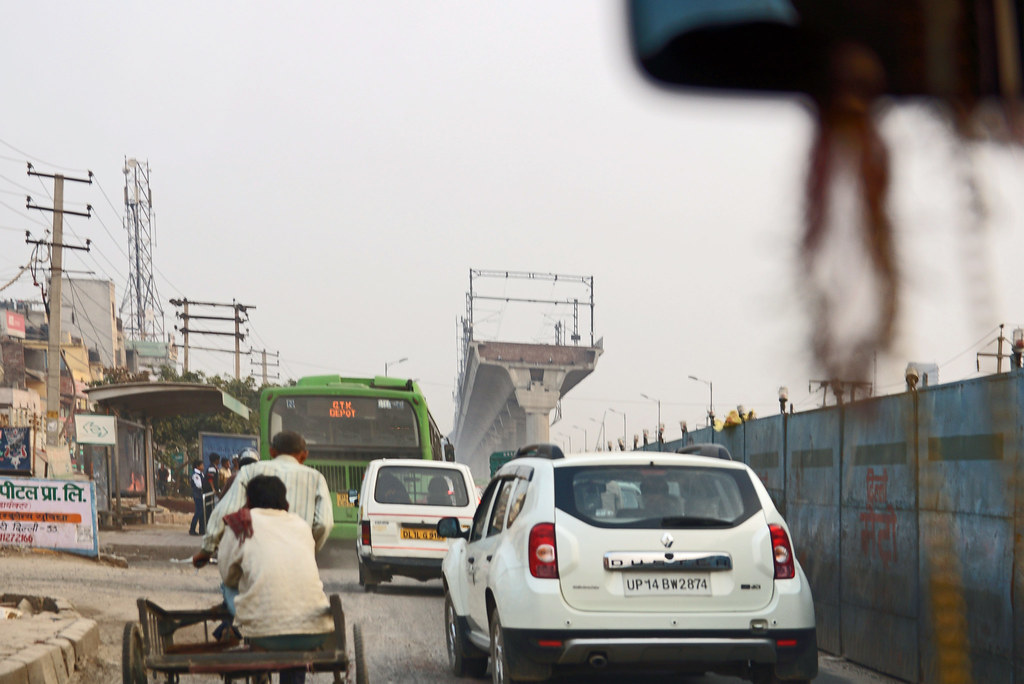
Again we were astonished by the enormous change occurring in the Indian capital. The whole city more and more resembled a construction area.
We left the centre of the city on a northern arterial road (NH1), leading to the city of Ambala, 150 km from Delhi in the Haryana state, and further to Indian and then Pakistani Punjab up to Lahore. At this moment we had no presumption that our destination has a certain connection with the Punjab. Anyway, it was already at Kilometre 20 of G.T. Karnal Road in Alipur. From the highway-like street we had seen a big temple complex, which gave an idea to Aparigraha Jain of the location to go. Right, we were approaching Atma Vallabh Smarak Jain Mandir! The temple had been founded by the female disciple of a Svetambara Acharya who had been given as term of endearment “Kesari (sweet dish) of Punjab” by the people. Details will be told later. First of all the way to temple complex had to be found. Our host radiated with joy when he saw that we threw big admiring eyes at the site even before having left the car. This surprise was very successful. It was not the only one this afternoon.
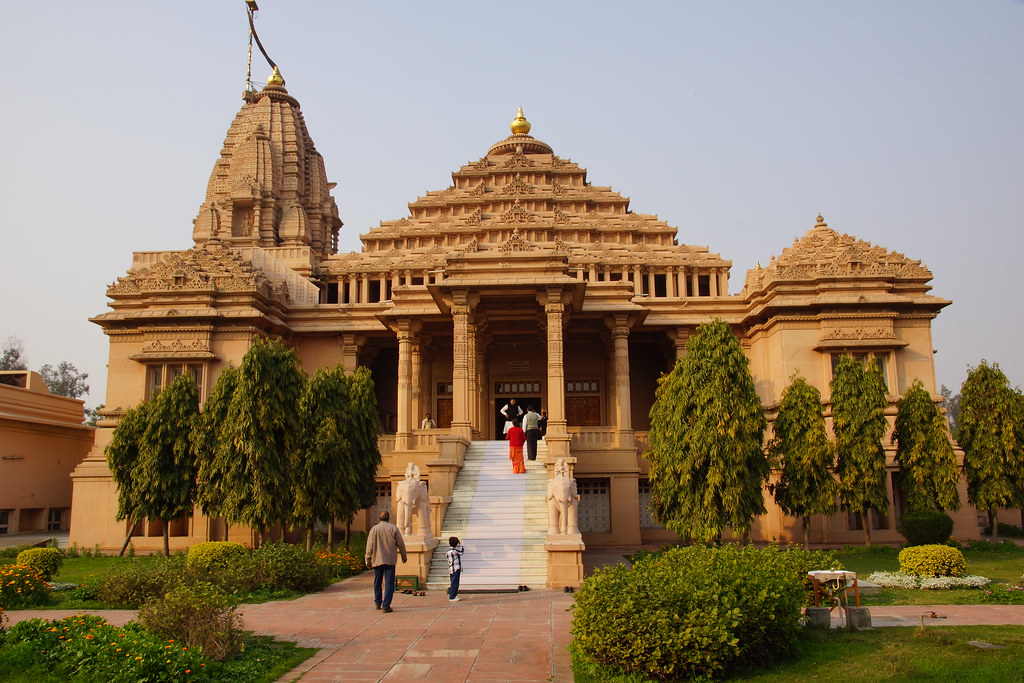
From the parking place we approached the side entrance of Atma Vallabh Smarak Jain Mandir. On the verge of the stairs Vidhya Saggar ji Garg and his grandson Arham.
This impressive Svetambara temple is situated in a neatly cultivated broad complex, surrounded with trees and flowers. The Bhogilal Leherchand Institute of Indology was founded here in 1984. The Museum Of Jain Art & Culture is displaying collections belonging to the medieval tradition of sculptures of the Tirthankaras and ancient paintings from western India, mainly Rajasthan, Gujarat, and Maharashtra, as well as literary artefacts of the Jain Agam Literature. Like in many other Shvetambara temple complexes accommodation for devotees is available.
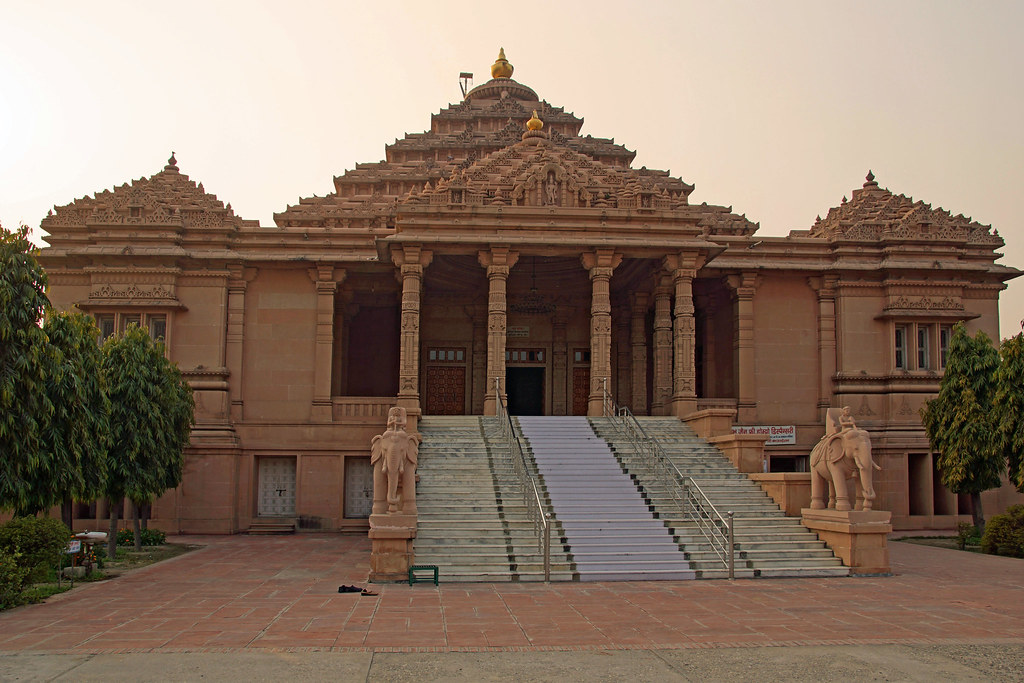
Main entry of Atma Vallabh Smarak Jain Mandir, also visible from NH1 road.

First we looked at the temple from outside, detailed view on the artful roof.
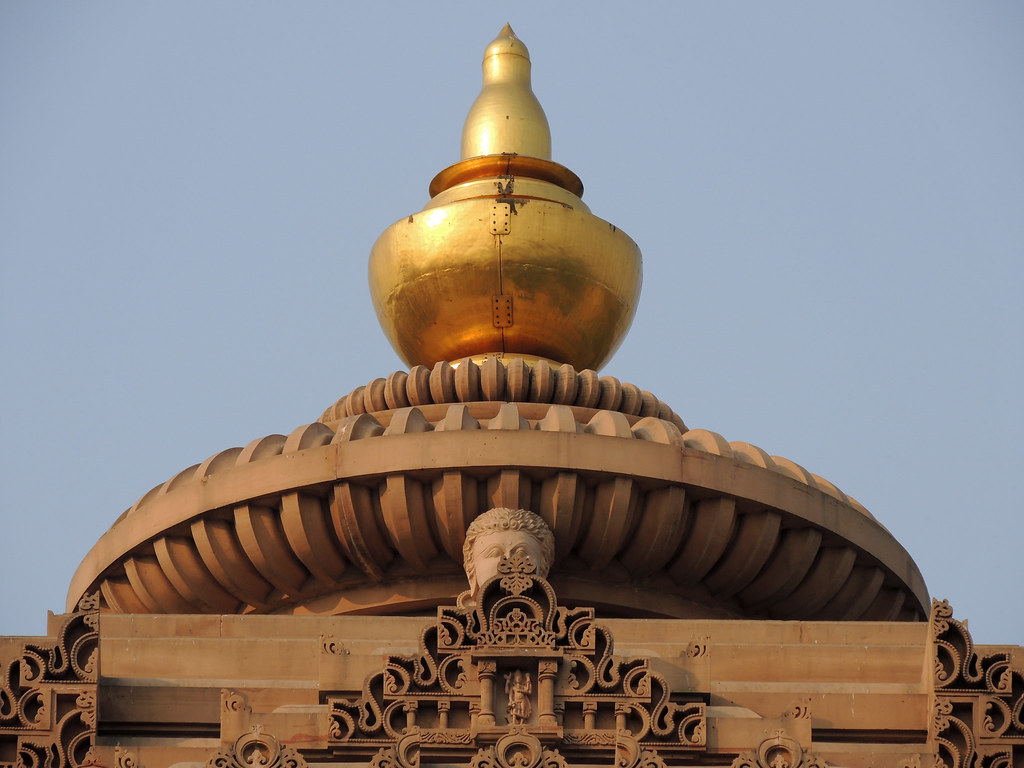
The golden top was illuminated by the afternoon sun. For many drivers on NH1 this is a familiar look.
We went back to our initial point at the side entrance and from there headed to the Garbhagriha in the upper store. The sculptures of four Tirthankaras are installed in the sanctum sanctorum: Vasupujya (1st), Parshvanatha (23rd), Munisuvrata (20th), Adinatha / Rishabhanatha (1st). Each of them looking into another direction.
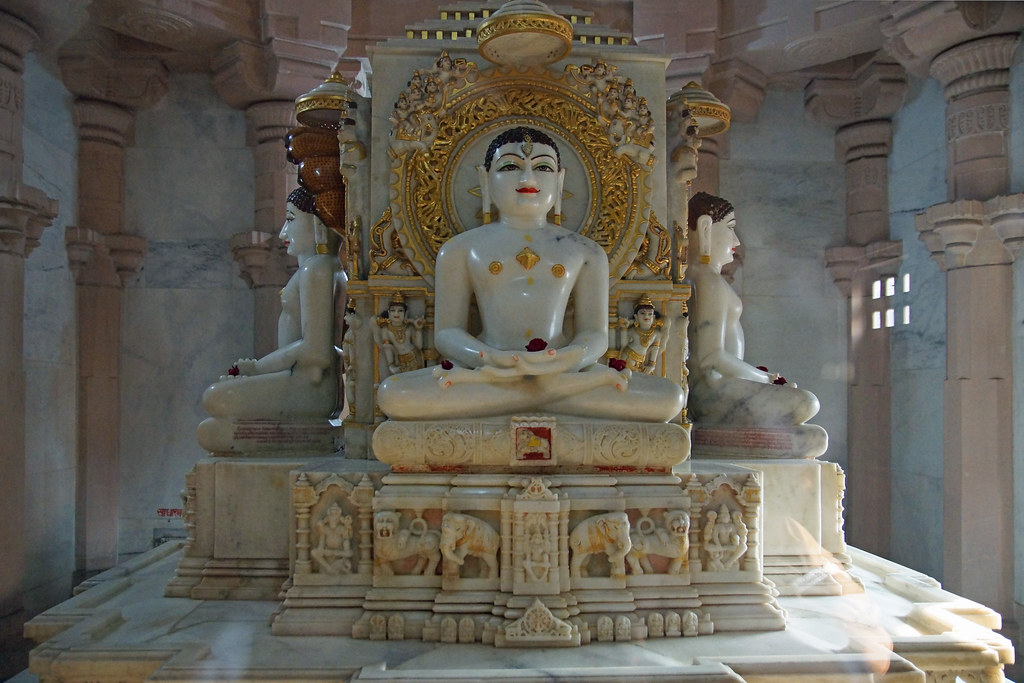
12th Tirthankara Vasupujya
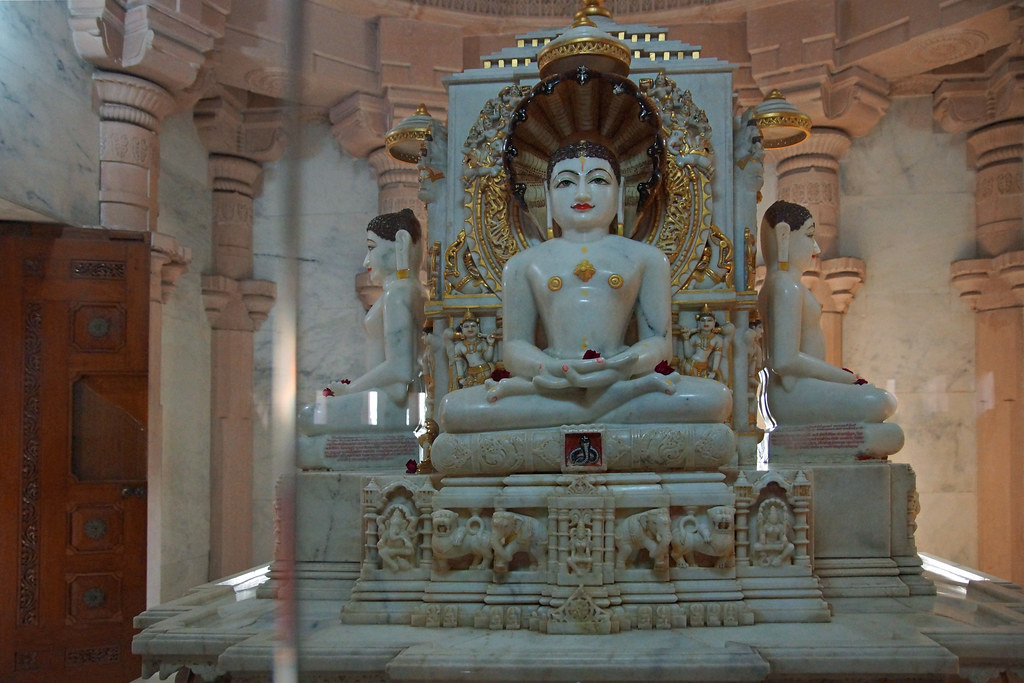
23rd Tirthankara Parshvanatha
The sculptures also were adorned with fresh roses. All 4 statues of the Tirthankaras are made of finest polished marble. This and the golden marks on their chests give a heavenly shine to them whenever met by rayon of light. Sunlight only rarely comes in the Garbhagriha, which mostly is in semi-darkness. There the sculptures literally are glowing.
We were carried away and absorbed by this beauty, when Vidhya Saggar ji Garg gave us sign to follow him. His expression was difficult to interpret.
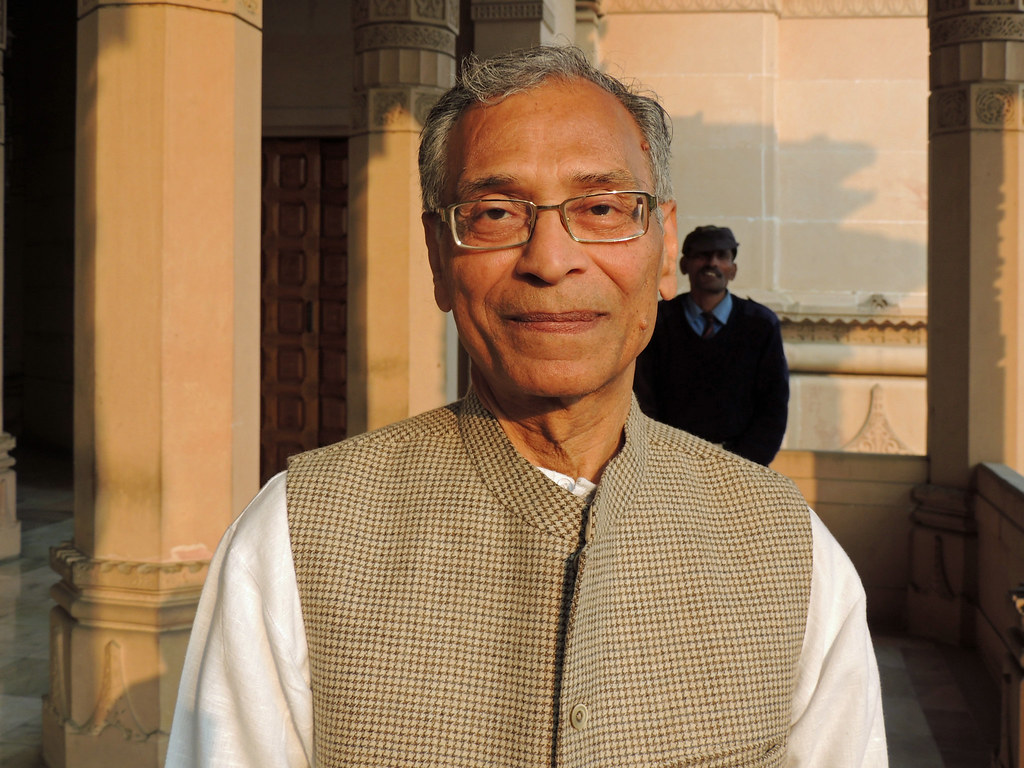
Prof. G.C. Tripathi, academic director of Bhogilal Leherchand Institute of Indology.

Prof. Tripathi, Vidhya Saggar ji Garg, Vandana Garg (turning her back to the camera), in the background the splendid park
Vidhya Saggar ji Garg introduced us to Prof. Tripathi whom he had met by chance when looking for someone being able to explain us in detail the facts on the temple. When the latter got to know that our host was accompanied by friends from Germany he immediately went with our host to make our acquaintance. He addressed us to our great surprise and joy in German language. Not only this, his command over German language is impressing! From 1963-66 he has been to Freiburg University as a student, and then returned from 1973-77 as a lecturer! When we complimented him on his perfect German language, he modestly smiled and added not to have forgotten his German language skills. After more than 45 years! Later he told us that he regards Germany as his second homeland and therefore is very happy to meet German visitors. For him and us this meant that he voluntarily took us around and explained all that we saw during the hours of our stay in German language! How wonderful, in German language. This was the first time that an expert as qualified as Prof. Tripathi gave the informations we longed for in our mother tongue in a Jain temple. An unforgettable encounter.
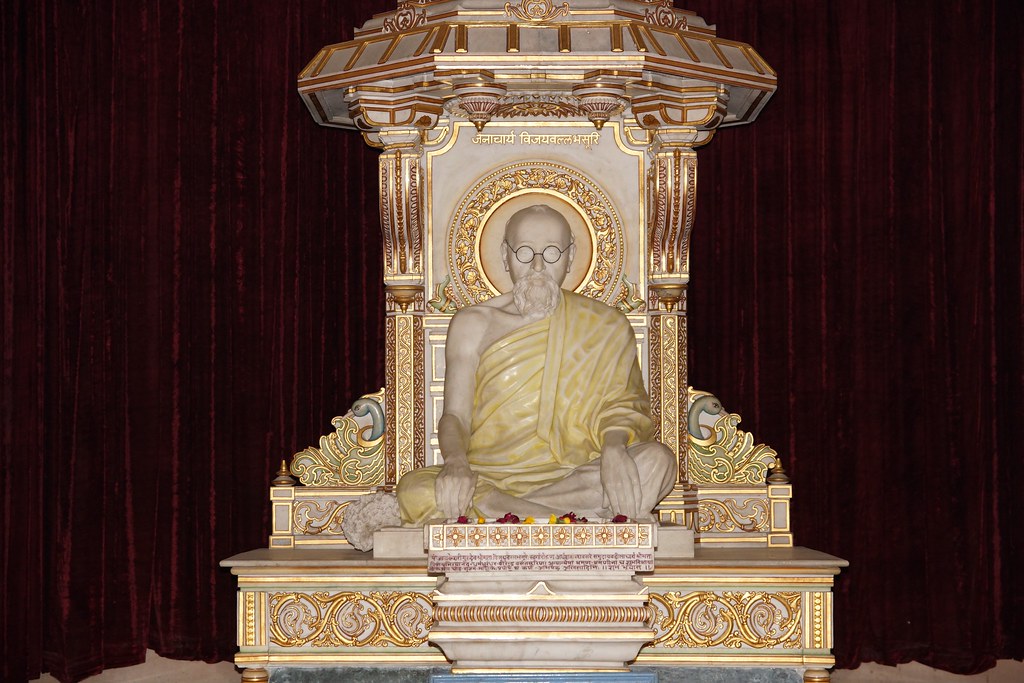
Acharya Vijay Vallabh Suri to whom the temple is dedicated.
The sculpture of the great Jain Shvetambara Acharya Vijay Vallabh Suri is installed in the big hall of the temple, opposite the main entrance. His dedicated female devotee Sadhvi Mrigavati had the idea to honour his memory with the foundation of a temple at the random of the old NH1, on which he once was rambling to Punjab and then back to Mumbai. When she saw the then savaged broad areal she got the inspiration that this location is appropriate for the project she had in mind. In Punjab Acharya Vijay Vallabh Suri was significantly involved in educating the poor and disadvantaged mentally and spiritually. For that purpose he had founded hospitals, schools, and educational institutions attached to temples. His life and work until present have an impact on the many social and research assignments of his followers. He embodies especially the social lessons one might conclude from teachings and lives of the Tirthankaras.
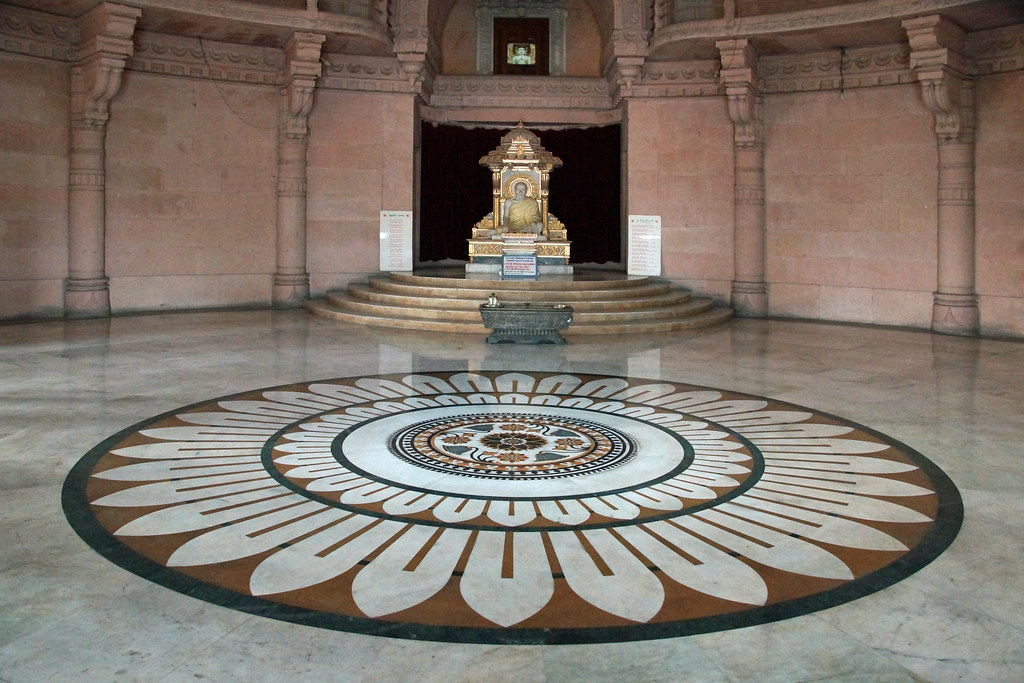
Entering the big hall, the artfully inlaid marble floor is the first eye-catcher, followed by the sculpture of the Acharya, about whose head the depiction of 23rd Tirthankara Parshvanath seems to float.
The temple was built after a Gujarati prototype dating back to 2nd century CE and completed towards the end of 20th century. The construction material, including the columns, consists of grout and sandstone only, neither cement nor steel or iron. The upper store is borne by the half-round walls and the ceiling. In the middle of the marble inlaid floor a central point is formed by the design. Prof. Tripathi told us that many visitors had reported to him how strong the spiritual energy is there when sitting down for meditation..
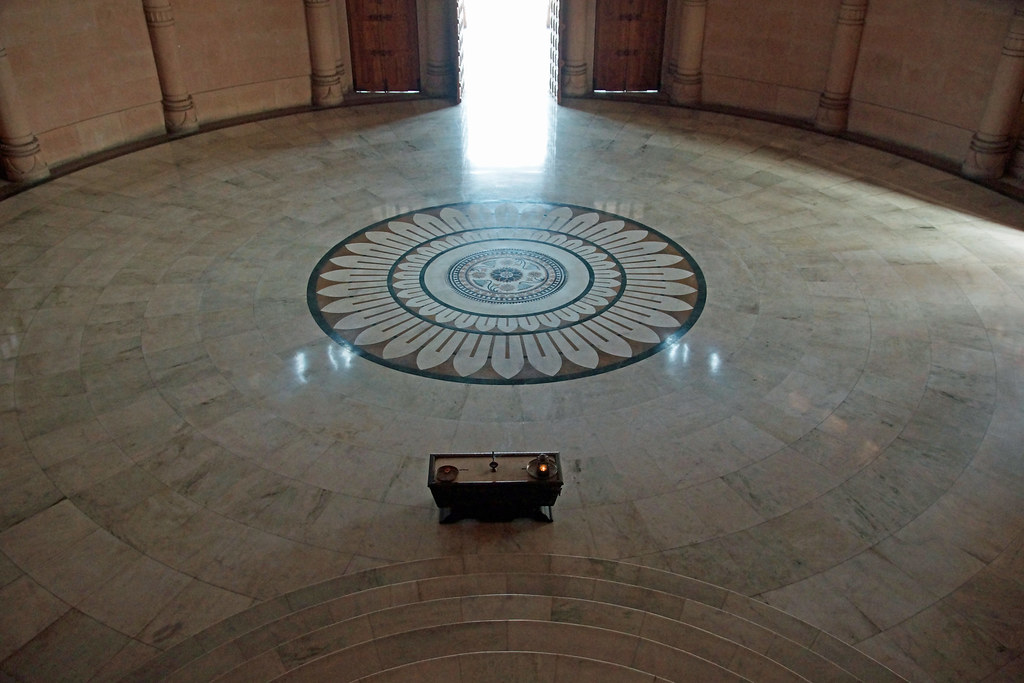
This might give an impression of what Prof. Tripathi told us.
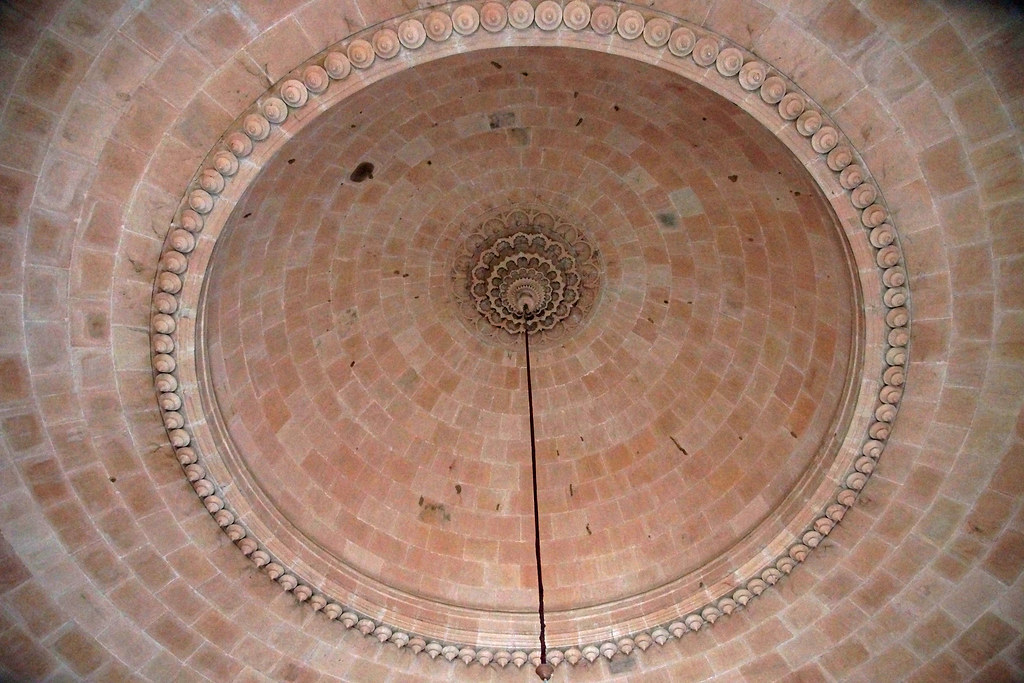
To construct this self-supporting ceiling sandstones have been interleaved in a traditional way.
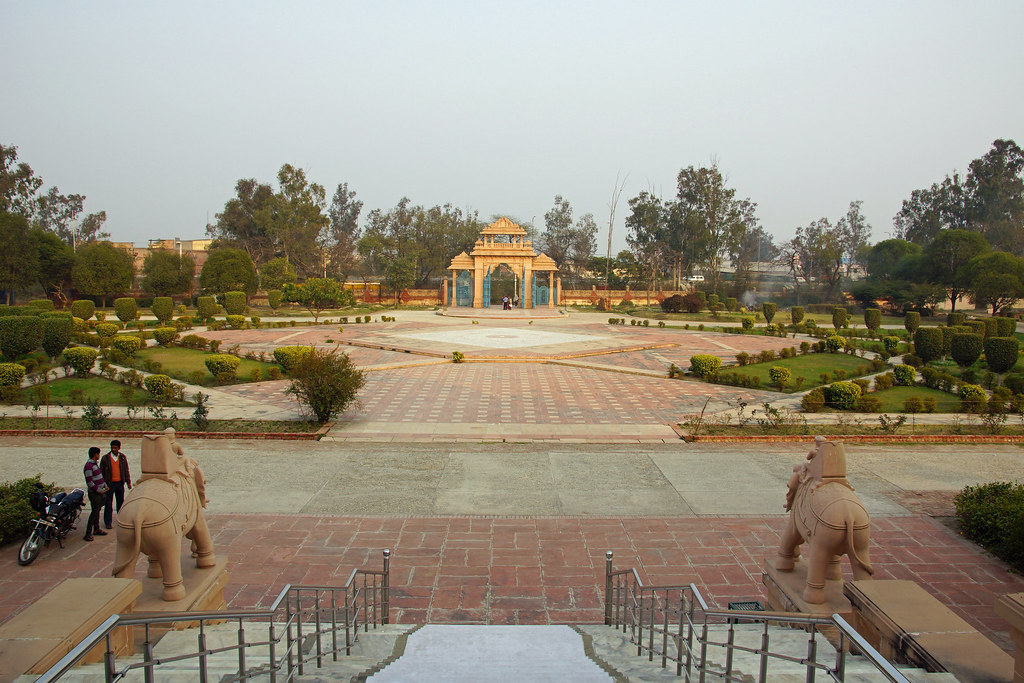
View from the big hall to the surrounding park. The old Karnal Road continues behind the gateway.
When we left the temple through the side entrance, Prof. Tripathi drove our attention to two special buildings. In our direct viewing line we saw a small turfy hill with an entrance made of the same red sandstone as the temple. This cave-like construction was erected as memorial for Sadhvi Mrigavati (1926-86). She died in the age of only 60 years on the areal, before the temple was finished. Her memorial was erected where her mortal remains were cremated. The urn containing her ashes was posed at the feet of her sculpture. Like her great master she advocated the education of the socially weak and founded many schools and other educational institutions attached to temples. The means to realize her vision were donated after she had vividly called for funds. Even nowadays she is remembered as an exceptionally gifted orator being able to reach the hearts of her listeners.
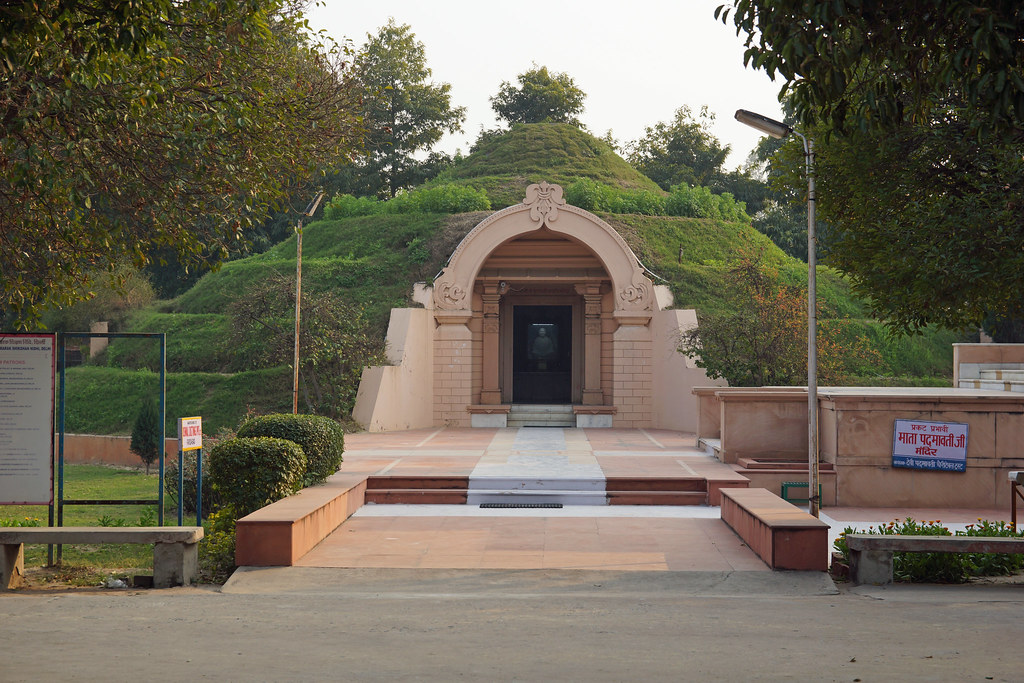
Memorial in honour of the great Jain saint and teacher Sadhvi Mrigavati.
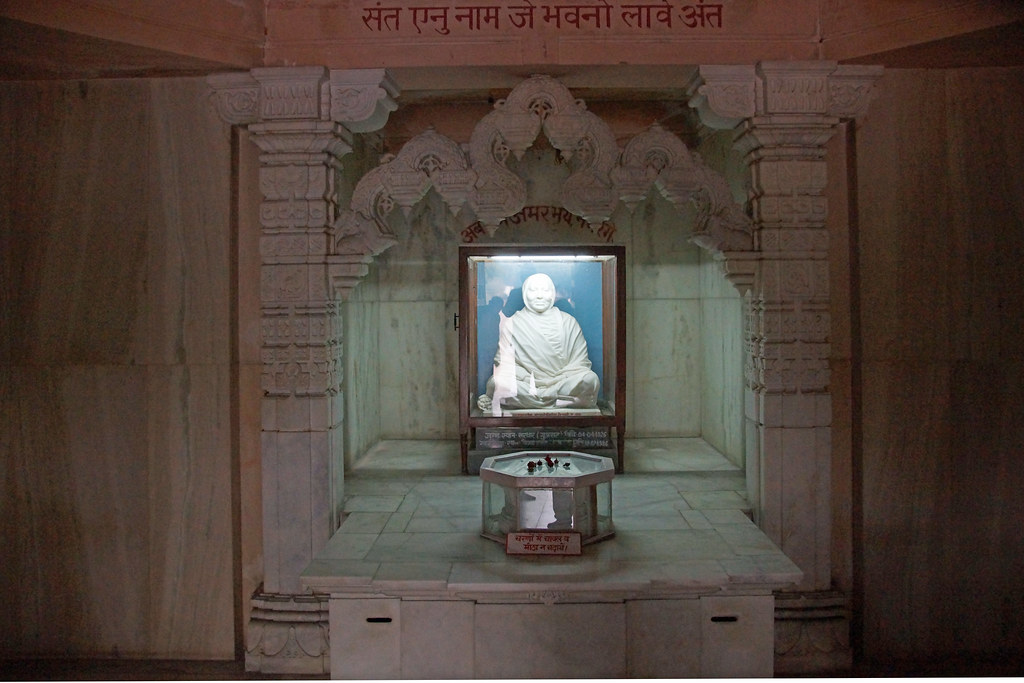
Sculpture of the foundress of the temple with the urn containing her ashes to her feet
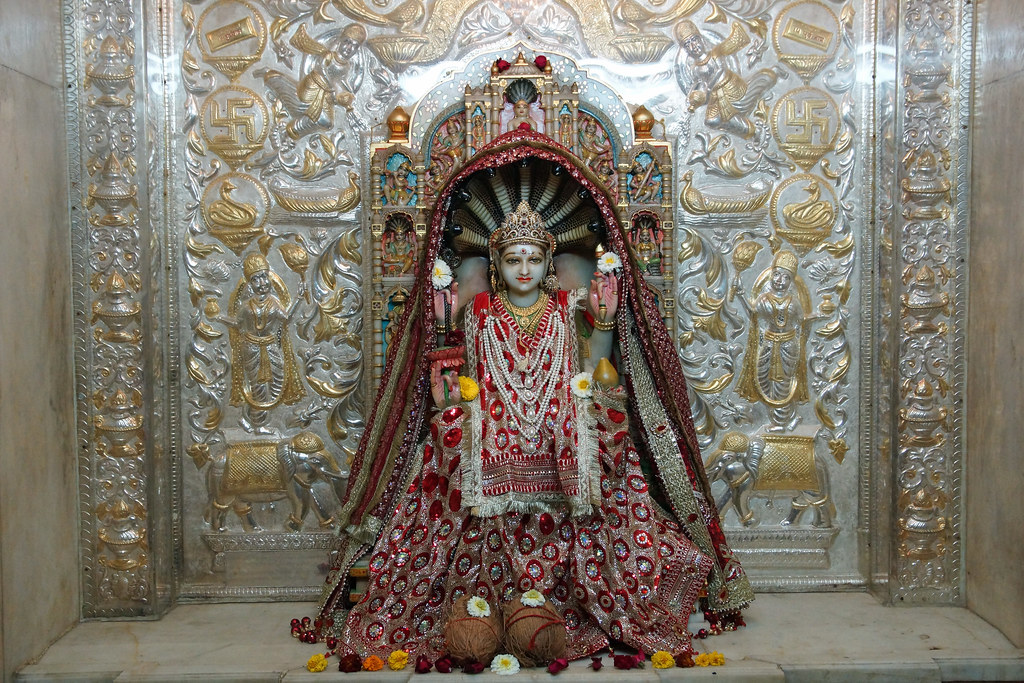
At the right of the foundress’ memorial is a small temple dedicated to Padmavati depicted with the hook.
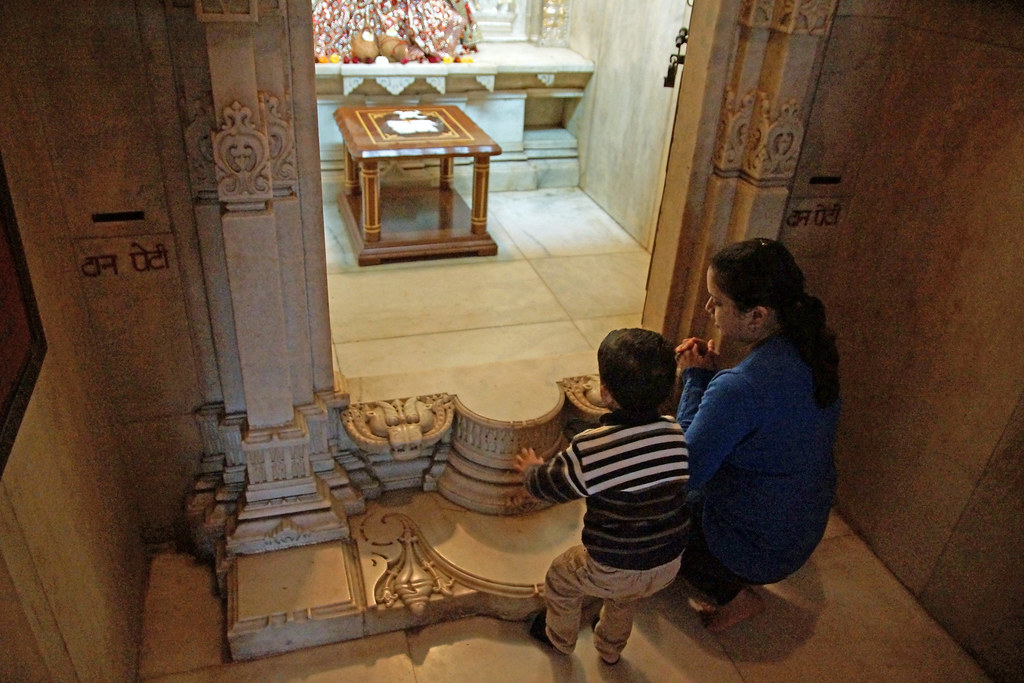
A mother and her son in devotion...[1]
We had an unforgettable Sunday and noticed by hindsight that we did not succeed in remembering all the many details which Prof. Tripathi had given to us. In fact we were overwhelmed by the natural grace of what we had seen and experienced. Such beauty and harmony make silent inside. Likewise effect has knowledge of details from the life of people who followed an extraordinary path of life, which brought them not only to the heights of successfully having changed the world into a better place for many, but even far beyond this! People with a great heart full of love to all forms and facets of life who long after they were gone are illuminating the hearts and minds of those hearing of them. Perhaps one feels closer to those people after a visit to a temple or a mosque or a church. Regardless of religious affiliation they are a source of inspiration and cogitation.
Days like this are a present, THANKS!
 Editor Carla Geerdes
Editor Carla Geerdes